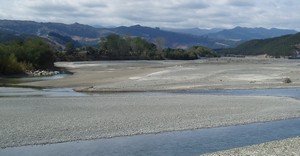Building community resilience to climate change

The Waiapu River has the highest sediment loading of any river in New Zealand and the flow on effect for the community is huge.
Erosion, low incomes, poor infrastructure and population migration leave many rural communities in New Zealand vulnerable to climate related impacts, and unable to take advantage of opportunities for a better future.
Scion scientists Tim Barnard, Duncan Harrison, Luke Barry and Loretta Garrett, are working with Ngati Porou researchers and Gerard Fitzgerald (Fitzgerald Applied Sociology) to explore ways to build community resilience to the impacts of climate change through effective forest strategies. Their research is focused on the Waiapu Catchment on the East Coast, one of the most vulnerable rural communities in the country.
“Forests have a key role to play in the restoration of cultural values and community wellbeing as well as the degraded landscapes in the region,” says Tim Barnard, Forest Environment and Economics Team Manager and project leader.
“Communities in the Waiapu catchment and Ngati Porou in particular, have been dealing with the effects of environmental, social and economic shock for over a century. Heavy deforestation has led to years of erosion. The Waiapu River has the highest level of sediment loading of any river in the country and the flow on effect for the community is huge.”
Previous strategies to re-forest vulnerable land in the catchment have not been as successful as hoped. Lack of resourcing has been a key issue, along with wider challenges facing the community such as the availability of seasonal food and fresh clean water, and the on-going loss of human and social capital. These have all led to reduced community functioning, wellbeing, loss of services and marginalisation.
Wholesale deforestation of the land for farming began in the late 1880s with the arrival of Europeans, causing rapid erosion and landslides. This created gullies that have been expanding for decades. Natural weather extremes such as Cyclone Bola and other large storms have also taken their toll.
The Waiapu catchment is of considerable spiritual, cultural and economic significance to Ngati Porou. Scion is now working alongside the community to develop an integrated afforestation programme that will provide employment for local people, opportunities for innovation, entrepreneurship and regional economic development, and that embraces Ngati Porou’s aspirations for economic independence.
Research to date has provided insight into the extent of erosion and degradation of the river. Through interviews, hui and workshops held with the community, the research team has also developed a bi-cultural framework of climate change indicators and a socio-economic profile of the community that provide a measure of community well-being.
“So far we’ve determined indicators that affect the community in some way,” says Tina Porou, former director and acting chief executive of Ngati Porou Whanui Forests. “For example, changing natural indicators derived from matauranga Maori, understanding the values underpinning exotic and native forestry, and sustainable development options for Ngati Porou to consider for the future.
“We now need to determine what scope there is for change, and practical solutions that will turn aspirations into reality. We have to figure out how to get institutions and private investors on board with understanding the needs of Ngati Porou in dealing with the effects of climate change.
“Tim and the team have a passion that makes me more appreciative of my environment and the potential there is on the East Coast. It’s a positive move by Scion being so proactive about meaningful research for Maori communities.”
Contact: Show email
